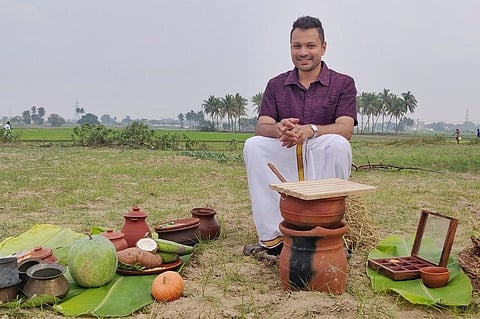

Food is a great cultural marker. Every food item brings with it, a treasure trove full of stories which leads its consumers to delightful discoveries. Analysing the origins of food and how it has changed over the generations to assume its present form is, in itself, an interesting domain to look at. Rakesh Raghunathan, a familiar face in literary and restaurant circles for his workshops and lecture-demonstrations on traditional south Indian food, has been travelling across the five southern states for the past five years, looking for traditional recipes of native dishes and documenting them.
His trips in recent times and the discoveries he makes during those form the core idea of Living Foodz channel’s new show Dakshin Diaries.
“The idea was to look beyond the usual idli and sambar in Tamil Nadu,” Rakesh tells TNM.
A commerce graduate who went on to earn an MBA, Rakesh says he was always intrigued by food, especially south Indian cuisine. “My mom is a fabulous cook herself, but when she tells me that her grandmother was a much better cook and that she wished she had learnt her recipes, it struck me. Every generation is letting go of these recipes,” he says, adding that this is how the idea to document food came to him. However, it was much later in life that he embarked on that journey.
Experimenting with food business
Launching a food business was something that Rakesh experimented with early on. PetaWrap, a fast-food chain, taught him that it was not easy to run a food business.
“I learnt that running a food business is way different from just being interested in food. PetaWrap was an experience about managing people, logistics etc,” he explains.
Not enjoying his time with PetaWrap, he ventured into researching about food and its history, starting with temple prasadams. Puliogare Travels, a Facebook page, which documents his travels and food expeditions, was a medium which helped him express his discoveries and feelings about food that he encountered during his tours.
Food of the Gods
“There is more to temple prasadams beyond religion. These prasadams are documented in texts written 5,000 years ago which help us understand the economy of the region, the vegetation, flora and fauna and the occupation of the people who lived in that place. You get to know everything about the lives of those who lived there in that era,” he says.
Sharing one of the most memorable moments involving a temple prasadam, Rakesh says that akkara adisal, a dish made with rice, jaggery and milk, is the dish that made him look at food in wonder. “I love making akkara adisal. In Nachiyar Thirumozhi, Andal mentions this dish saying that she will cook and offer it if she ends up marrying her Lord. A dish as old as the text is made even today by people. So, after reading this and then eating it for the first time, I thought, well, I am actually biting into a slice of history,” Rakesh reminisces.
Thus he set out to villages in Tamil Nadu and began exploring food and regional dishes which are unique to the place. “I went around small villages, talked to people, documented the local snacks, recipes etc. I travelled across south India to know more about food and document it,” he says.
On contemporary food habits and their roots
Speaking about the present era in which consumers are exploring varieties of food which date back to several centuries, Rakesh says that the trend is old wine in a new bottle.
“I feel a retro-trend of food habits is catching up now. In those days, millets and organic vegetables were used casually because only those were available at economical prices,” he points out, adding that the curiosity of the millennials to connect with their roots is very much alive now. “A lot of people now want to know the story behind a dish,” he says.
Similar is the trend of using utensils made of metals like copper and brass. “Metals infuse a distinct flavour into food. There was a logical connect when people of those days used clay pots, terracotta pots, brass vessels to make food,” Rakesh says, giving the example of setting curd in a clay pot. “The clay pot absorbed a good amount of water from the curd and the resultant product will be really thick,” he explains. He also cites how people used to store and drink water from copper vessels back in the day because steel wasn't so easily available, and relates the practice to the current idea of flaunting copper bottles.
Start with appreciating the cook
What is Rakesh’s favourite food, I ask. Pat comes the reply – "I think it should be the puliodharai."
“It is a laborious process to make it according to the real recipe. To make a good puliodharai is no joke,” he claims.
Shedding light on how one can begin diving deep into the culinary art of the yore, Rakesh says the starting point is at one’s own home.
“I think where we all can begin is by talking to people in our family who cook well. They would invariably have certain peculiar cooking techniques and mixes that only they would know. So, if there is a fabulous cook in your home, start by talking to him or her,” he says. He also says that Sangam literature has a lot about food, crops, cultivation patterns etc geography-wise.
While Rakesh is just back from a hectic travel schedule across south India, filming for Dakshin Dairies, a programme in the Living Foodz channel, he says writing a book is also on the cards.
“I want to push boundaries and talk about society, communities and food that people don’t really talk about. Food connects people and is a conversation starter which leads to discussions across communities and divisions,” he signs off.